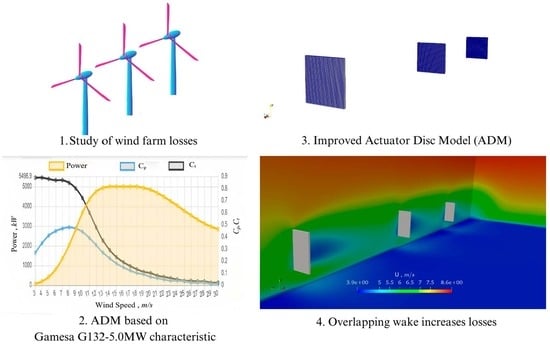Modeling of Wind Turbine Interactions and Wind Farm Losses Using the Velocity-Dependent Actuator Disc Model
Abstract
:1. Introduction
2. Materials and Methods
2.1. Mathematical Model
2.2. Numerical Model and Implementation
- 1.
- A single column of 3 turbines 5D apart on land (WF1).
- 2.
- A multi-column wind farm composed of 3 rows 5D apart on land (WF2).
- 3.
- A single column of 3 turbines 10D apart on land (WF3).
- 4.
- A multi-column wind farm composed of 3 rows 10D apart on land (WF4).
- 5.
- A single column of 3 turbines 5D apart on sea (WF5).
- 6.
- A multi-column wind farm composed of 3 rows 5D apart on sea (WF6).
- 7.
- A single column of 3 turbines 10D apart on sea (WF7).
- 8.
- A multi-column wind farm composed of 3 rows 10D apart on sea (WF8).
3. Results and Discussion
Estimation of Losses in Wind Farms
4. Conclusions
Author Contributions
Funding
Data Availability Statement
Conflicts of Interest
References
- GWEC. Global Wind Report 2023; Technical Report; Global Wind Energy Council: Brussels, Belgium, 2023. [Google Scholar]
- Ember. Available online: https://ember-climate.org/topics/wind/ (accessed on 18 July 2023).
- IRENA. Available online: https://www.irena.org/Energy-Transition/Technology/Wind-energy (accessed on 14 September 2023).
- Numerical study of improving Savonius turbine power coefficient by various blade shapes. Alex. Eng. J. 2019, 58, 429–441. [CrossRef]
- Beiter, P.; Rand, J.T.; Seel, J.; Lantz, E.; Gilman, P.; Wiser, R. Expert perspectives on the wind plant of the future. Wind Energy 2022, 25, 1363–1378. [Google Scholar] [CrossRef]
- Lissaman, P.B.S.; Gyatt, G.W.; Zalay, A. Critical issues in the design and assessment of wind turbine arrays. In Proceedings of the 4th International Symposium on Wind Energy Systems, Stockholm, Sweden, 21 September 1982; Volume 2, pp. 411–423. [Google Scholar]
- Malecha, Z. Economic analysis and power capacity factor estimation for an offshore wind farm in the Baltic Sea. Instal 2023, 1, 4–11. (In Polish) [Google Scholar] [CrossRef]
- Jedral, W. Generation and storage of large amounts of electricity in the energy transition by 2050. Energetyka Ciepl. Zawodowa 2022, 816, 44–50. (In Polish) [Google Scholar]
- Jedral, W. Production of 100% electricity in Poland from RES—A real purpose or utopia? Rynek Energii 2022, 160, 3–15. (In Polish) [Google Scholar]
- Jedral, W. Energy storage and hydrogen power engineering in Poland as a result of the power engineering transformation. Rynek Energii 2022, 161, 8–15. (In Polish) [Google Scholar]
- Boccard, N. Capacity factor of wind power realized values vs. estimates. Energy Policy 2009, 37, 2679–2688. [Google Scholar] [CrossRef]
- White, E.; Kutz, D.; Freels, J.; Monschke, J.; Grife, R.; Sun, Y.; Chao, D. Leading-Edge Roughness Effects on 63(3)-418 Airfoil Performance. In Proceeding of the 49th AIAA Aerospace Sciences Meeting Including the New Horizons Forum and Aerospace Exposition, Orlando, FL, USA, 4–7 January 2011. [Google Scholar] [CrossRef]
- Gao, L.; Liu, Y.; Zhou, W.; Hu, H. An experimental study on the aerodynamic performance degradation of a wind turbine blade model induced by ice accretion process. Renew. Energy 2019, 133, 663–675. [Google Scholar] [CrossRef]
- Gao, L.; Tao, T.; Liu, Y.; Hu, H. A field study of ice accretion and its effects on the power production of utility-scale wind turbines. Renew. Energy 2021, 167, 917–928. [Google Scholar] [CrossRef]
- Corten, G.; Veldkamp, H. Aerodynamics. Insects can halve wind turbine power. Nature 2011, 412, 41–42. [Google Scholar] [CrossRef]
- Malecha, Z.; Sierpowski, K. Badania numeryczne wpływu erozji oraz zabrudzeń łopaty na pracę turbiny wiatrowej. Instal 2023, 7–8. [Google Scholar] [CrossRef]
- Linnemann, T.; Vallana, G. Wind energy in Germany and Europe Pt 2 Status, potentials and challenges for baseload application: European situation in 2017. Int. Z. Fur. Kernenerg. 2019, 64, 141–148. [Google Scholar]
- Gawronska, G.; Gawronski, K.; Król, K.; Gajecka, K. Wind farms in Poland—Legal and location conditions. The case of Margonin wind farm. Gll Geomat. 2019, 3, 25–39. [Google Scholar] [CrossRef]
- DTI. Capital Grants Scheme for North Hoyle Offshore Wind Farm; Technical Report; Department of Trade and Industry: London, UK, 2006.
- DTI. Capital Grants Scheme for Scroby Sands Offshore Wind Farm; Technical Report; Department of Trade and Industry: London, UK, 2006.
- Malecha, Z. Risks for a Successful Transition to a Net-Zero Emissions Energy System. Energies 2022, 15, 4071. [Google Scholar] [CrossRef]
- Hansen, K.S.; Barthelmie, R.J.; Jensen, L.E.; Sommer, A. The impact of turbulence intensity and atmospheric stability on power deficits due to wind turbine wakes at Horns Rev wind farm. Wind Energy 2012, 15, 183–196. [Google Scholar] [CrossRef]
- Dahlberg, J.; Thor, S. Power Performance and Wake Effects in the Closely Spaced Lillgrund Offshore Wind Farm. In Proceedings of the European Offshore Wind 2009 Conference and Exhibition, Stockholm, Sweden, 14–16 September 2009. [Google Scholar]
- Sørensen, T.; Thøgersen, M.L. Recalibrating Wind Turbine Wake Model Parameters—Validating the Wake Model Performance for Large Offshore Wind Farms. In Proceedings of the European Wind Energy Conference and Exhibition, Athens, Greece, 27 February–2 March 2006. [Google Scholar]
- Lee, M.; Keith, D. Climatic Impacts of Wind Power. Joule 2018, 2, 2618–2632. [Google Scholar] [CrossRef]
- Harris, R.A.; Zhou, L.; Xia, G. Satellite Observations of Wind Farm Impacts on Nocturnal Land Surface Temperature in Iowa. Remote. Sens. 2014, 6, 12234–12246. [Google Scholar] [CrossRef]
- Slawsky, L.M.; Zhou, L.; Roy, S.B.; Xia, G.; Vuille, M.; Harris, R.A. Observed Thermal Impacts of Wind Farms over Northern Illinois. Sensors 2015, 15, 14981–15005. [Google Scholar] [CrossRef]
- Smith, C.M.; Barthelmie, R.J.; Pryor, S.C. In situ observations of the influence of a large onshore wind farm on near-surface temperature, turbulence intensity and wind speed profiles. Environ. Res. Lett. 2013, 8, 034006. [Google Scholar] [CrossRef]
- Zhou, L.; Tian, Y.; Baidya Roy, S.; Thorncroft, C.; Bosart, L.F.; Hu, Y. Impacts of wind farms on land surface temperature. Nat. Clim. Chang. 2012, 2, 539–543. [Google Scholar] [CrossRef]
- Zhou, L.; Tian, Y.; Baidya Roy, S.; Dai, Y.; Chen, H. Diurnal and seasonal variations of wind farm impacts on land surface temperature over western Texas. Nat. Clim. Chang. 2013, 41, 307–326. [Google Scholar] [CrossRef]
- Jacobson, M.; Delucchi, M.; Cameron, M.; Mathiesen, B. Matching demand with supply at low cost in 139 countries among 20 world regions with 100% intermittent wind, water, and sunlight (WWS) for all purposes. Renew. Energy 2018, 123, 236–248. [Google Scholar] [CrossRef]
- Jacobson, M.Z.; Archer, C.L. Saturation wind power potential and its implications for wind energy. Proc. Natl. Acad. Sci. USA 2012, 109, 15679–15684. [Google Scholar] [CrossRef]
- Jensen, N. A Note on Wind Generator Interaction; Number 2411 in Risø-M; Risø National Laboratory: Roskilde, Denmark, 1983. [Google Scholar]
- Katic, I.; Højstrup, J.; Jensen, N. A Simple Model for Cluster Efficiency. In EWEC’86. Proceedings. Vol. 1, Proceedings of the European Wind Energy Association Conference and Exhibition, Rome, Italy, 8–10 October 1986; Palz, W., Sesto, E., Eds.; A. Raguzzi: Rome, Italy, 1987; pp. 407–410. [Google Scholar]
- Göçmen, T.; van der Laan, P.; Réthoré, P.E.; Diaz, A.P.; Larsen, G.C.; Ott, S. Wind turbine wake models developed at the technical university of Denmark: A review. Renew. Sustain. Energy Rev. 2016, 60, 752–769. [Google Scholar] [CrossRef]
- Peña, A.; Réthoré, P.E.; van der Laan, M.P. On the application of the Jensen wake model using a turbulence-dependent wake decay coefficient: The Sexbierum case. Wind Energy 2015, 19, 763–776. [Google Scholar] [CrossRef]
- Sørensen, J. 2.08-Aerodynamic Analysis of Wind Turbines. In Comprehensive Renewable Energy; Sayigh, A., Ed.; Elsevier: Oxford, UK, 2012; pp. 225–241. [Google Scholar] [CrossRef]
- Martinez, L.; Leonardi, S.; Churchfield, M.; Moriarty, P. A Comparison of Actuator Disk and Actuator Line Wind Turbine Models and Best Practices for Their Use. In Proceedings of the 50th AIAA Aerospace Sciences Meeting including the New Horizons Forum and Aerospace Exposition, Nashville, Tennessee, 9–12 January 2012. [Google Scholar] [CrossRef]
- Richmond, M.; Antoniadis, A.; Wang, L.; Kolios, A.; Al-Sanad, S.; Parol, J. Evaluation of an offshore wind farm computational fluid dynamics model against operational site data. Ocean. Eng. 2019, 193, 106579. [Google Scholar] [CrossRef]
- Manwell, J.F.; McGowan, J.G.; Rogers, A.L. Wind Energy Explained: Theory, Design and Application; John Wiley & Sons: Hoboken, NJ, USA, 2010. [Google Scholar]
- Burton, T.; Jenkins, N.; Sharpe, D.; Bossanyi, E. Wind Energy Handbook; John Wiley & Sons: Hoboken, NJ, USA, 2011. [Google Scholar]
- OpenFoam and OpenCFD. Available online: https://www.openfoam.com/ (accessed on 22 April 2023).
- OpenFOAM and The OpenFOAM Foundation. Available online: https://www.openfoam.org/ (accessed on 22 April 2023).
- Issa, R.; Gosman, A.; Watkins, A. The computation of compressible and incompressible recirculating flows by a non-iterative implicit scheme. J. Comput. Phys. 1986, 62, 66–82. [Google Scholar] [CrossRef]
- Ferziger, J.H.; Peric, M.; Street, R.L. Computational Methods for Fluid Dynamics; Springer: Cham, Switzerland, 2020. [Google Scholar] [CrossRef]
- Moukalled, F.; Mangani, L.; Darwish, M. The Finite Volume Method in Computational Fluid Dynamics: An Advanced Introduction with OpenFOAM and Matlab; Springer: Cham, Switzerland, 2015. [Google Scholar] [CrossRef]
- Wind-Turbine-Models. Available online: https://en.wind-turbine-models.com/turbines/768-gamesa-g132-5.0mw#datasheet (accessed on 14 September 2023).
- Dailidiene, I.; Baudler, H.; Chubarenko, B.; Navrotskaya, S. Long term water level and surface temperature changes in the lagoons of the southern and eastern Baltic. Oceanologia 2011, 53, 293–308. [Google Scholar] [CrossRef]
- Svensson, N.; Arnqvist, J.; Bergström, H.; Rutgersson, A.; Sahlée, E. Measurements and Modelling of Offshore Wind Profiles in a Semi-Enclosed Sea. Atmosphere 2019, 10, 194. [Google Scholar] [CrossRef]
- Dahlberg, J.A.; Thor, S.E. Power performance and wake effects in the closely spaced Lillgrund offshore wind farm. In Proceedings of the European Offshore Wind 2009 Conference and Exhibition, Stockholm, Sweden, 14–16 September 2009; p. 1. [Google Scholar]

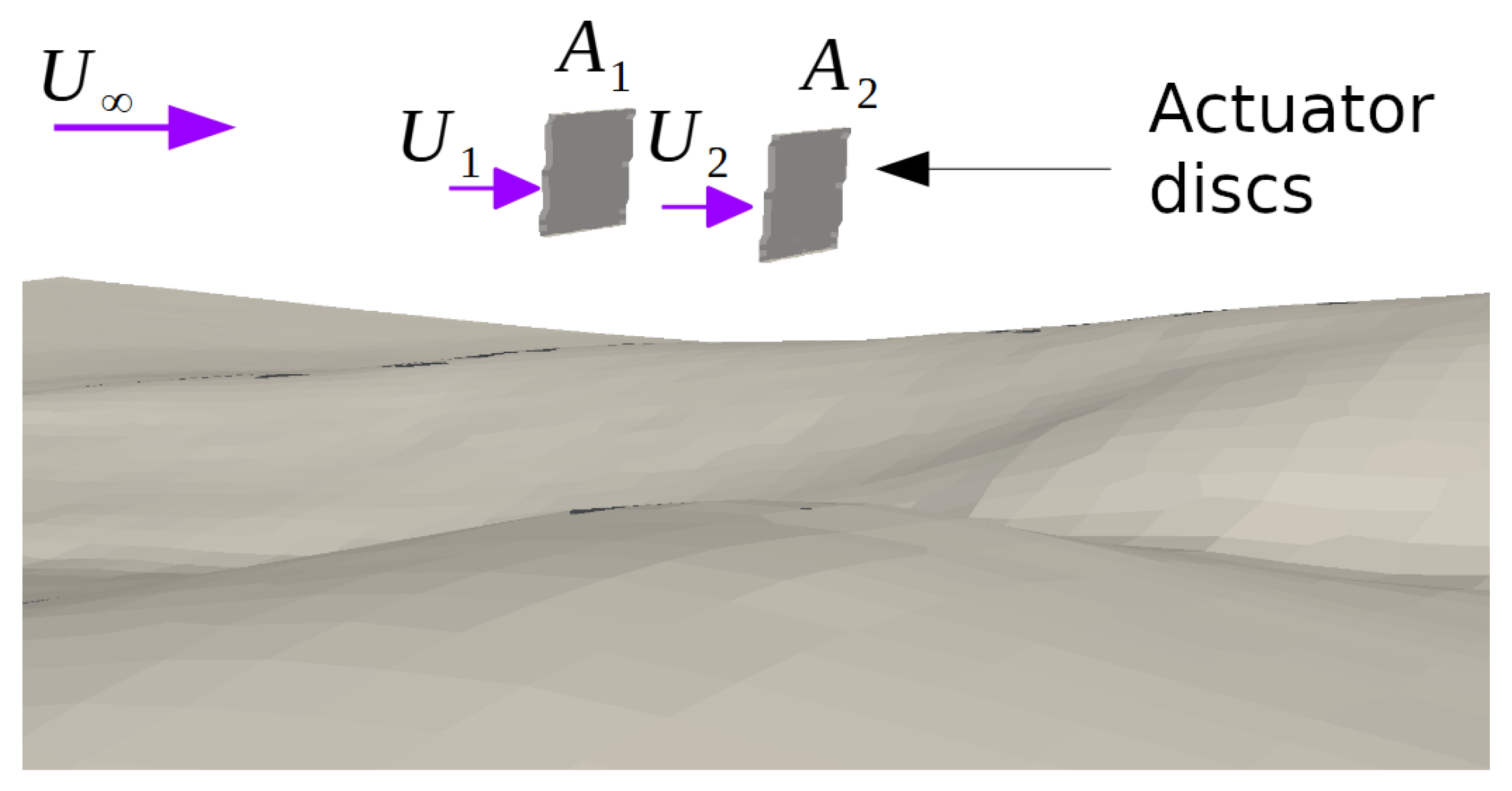
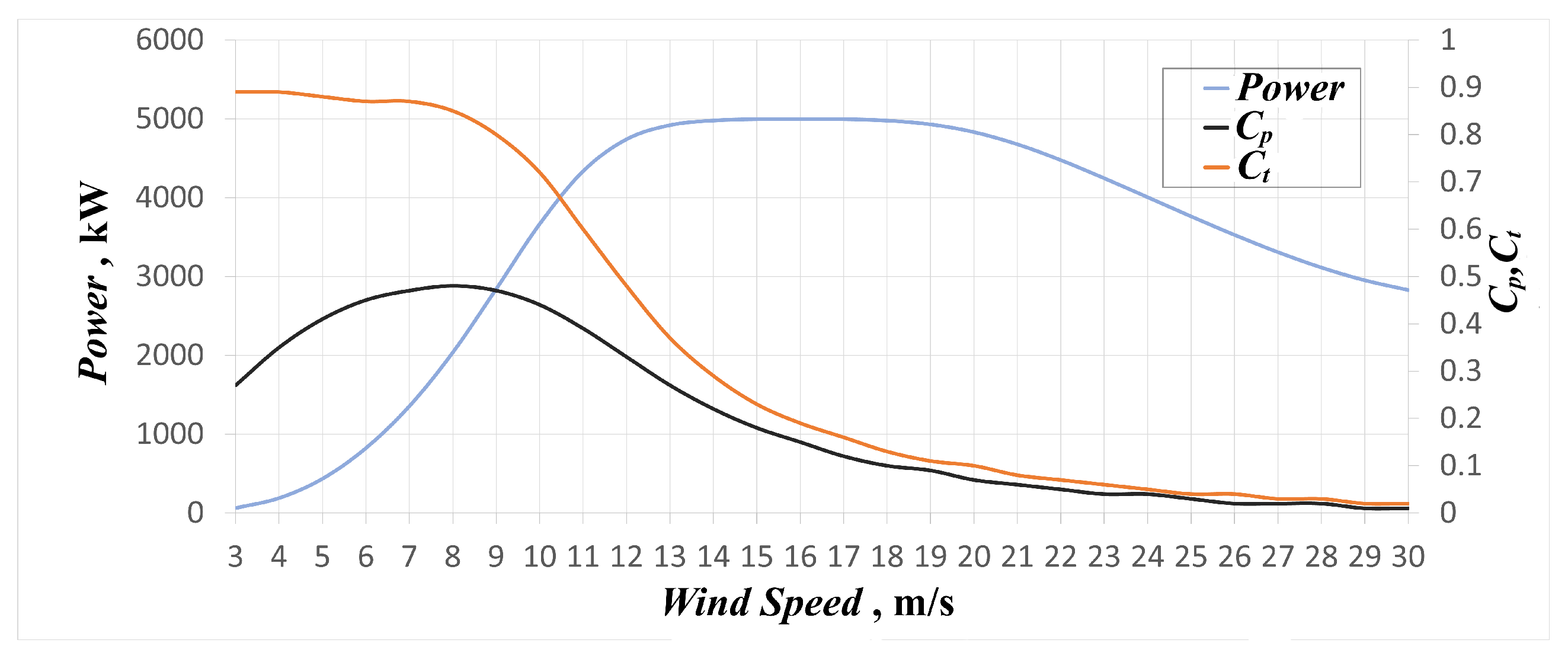
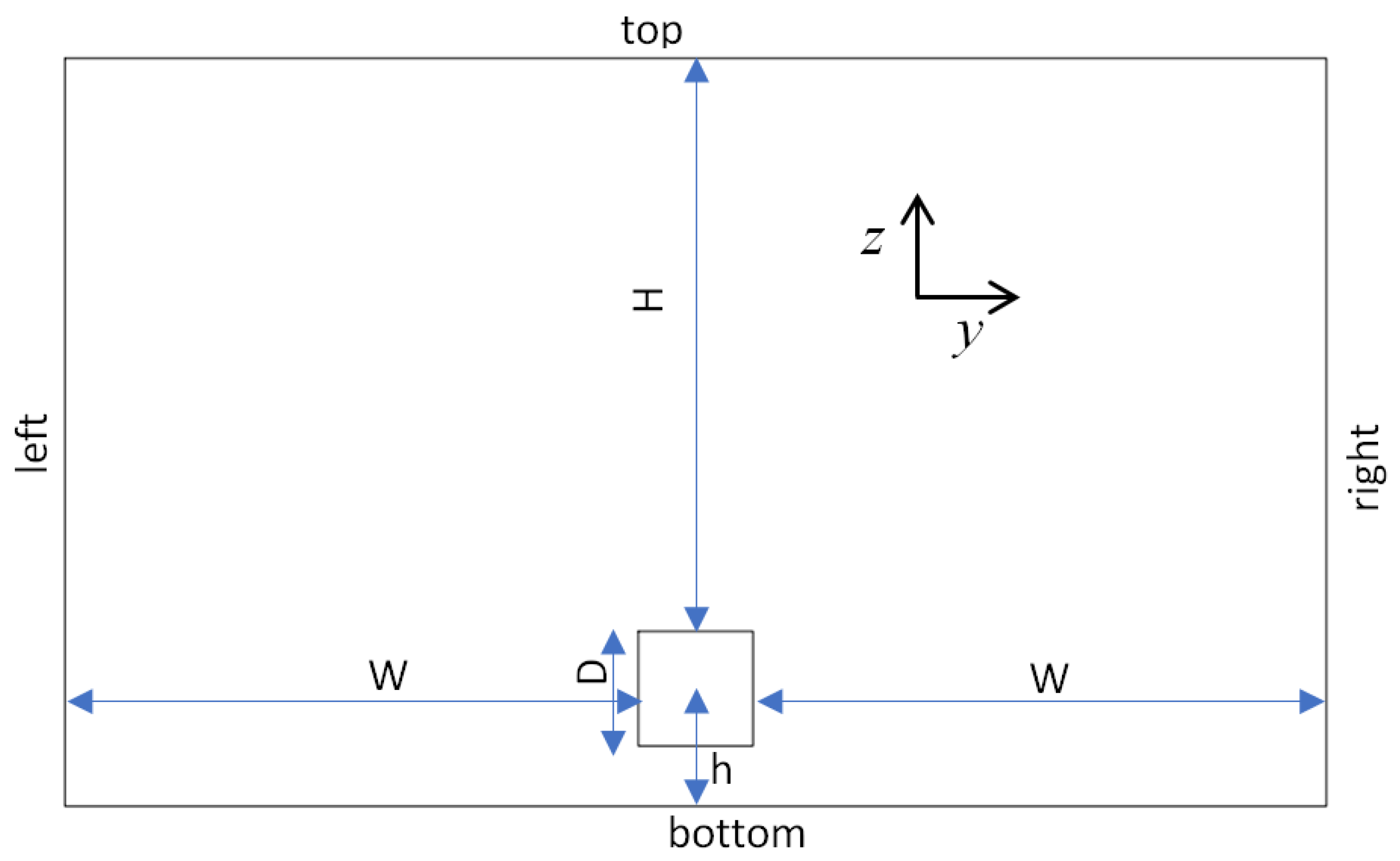
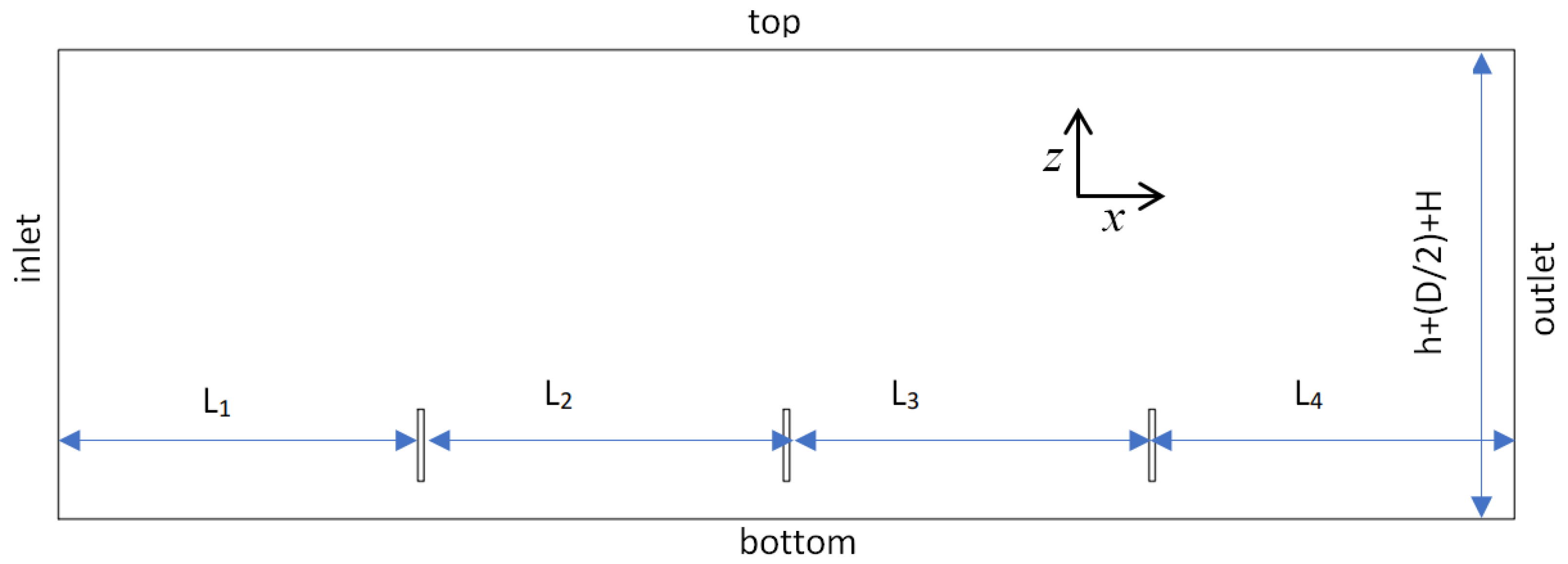
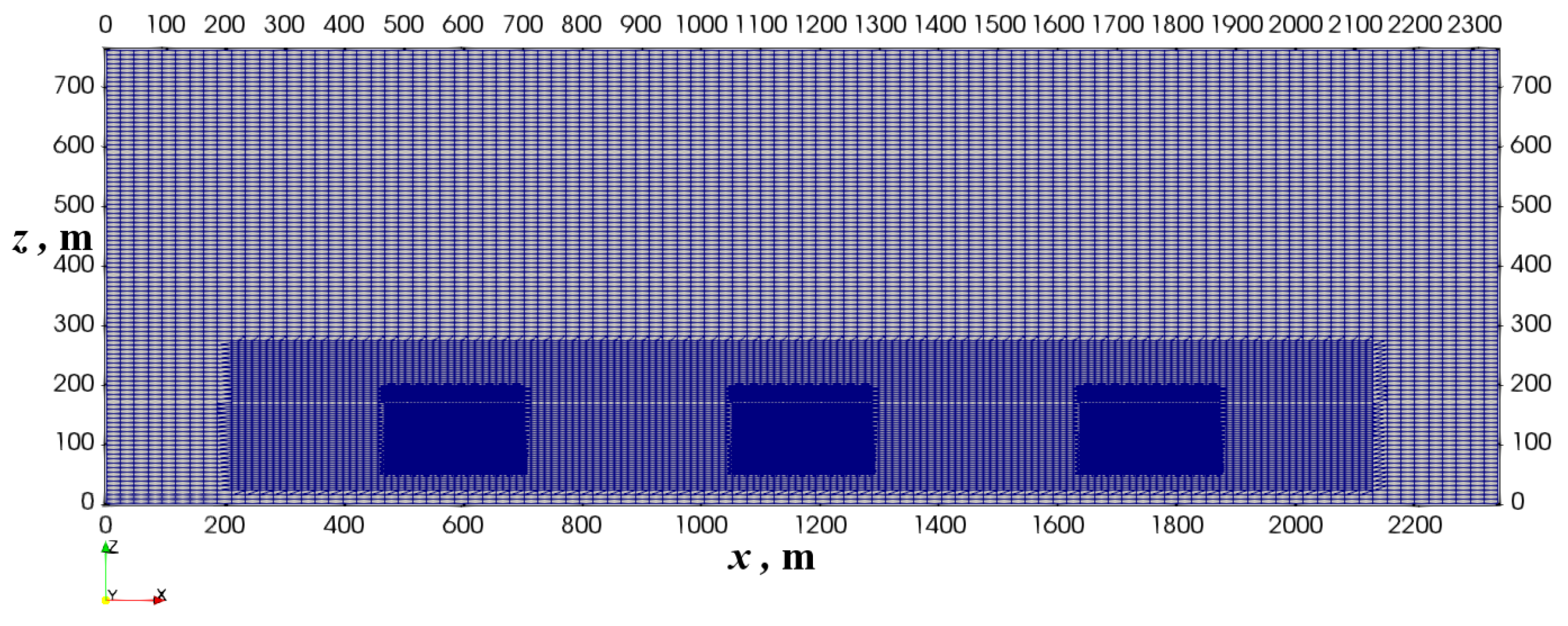

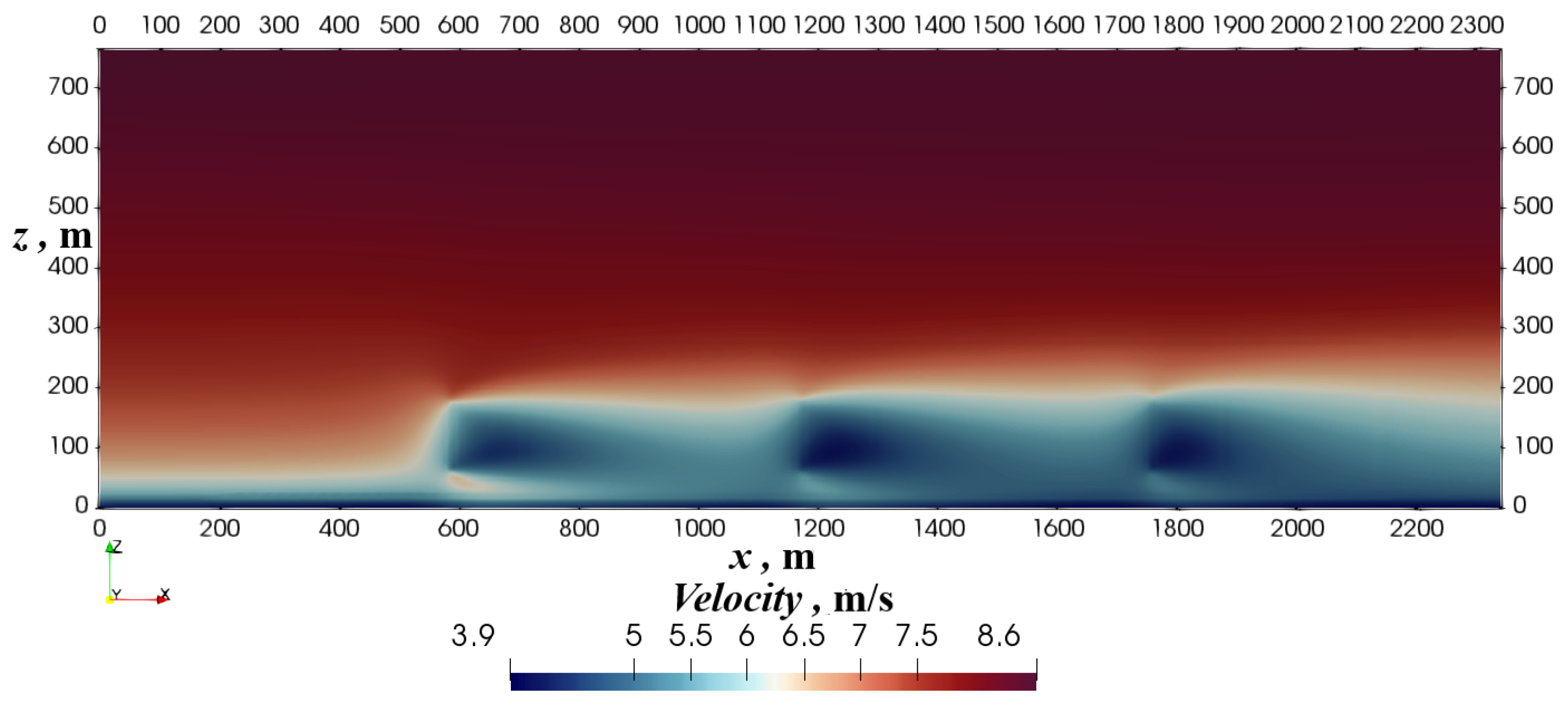
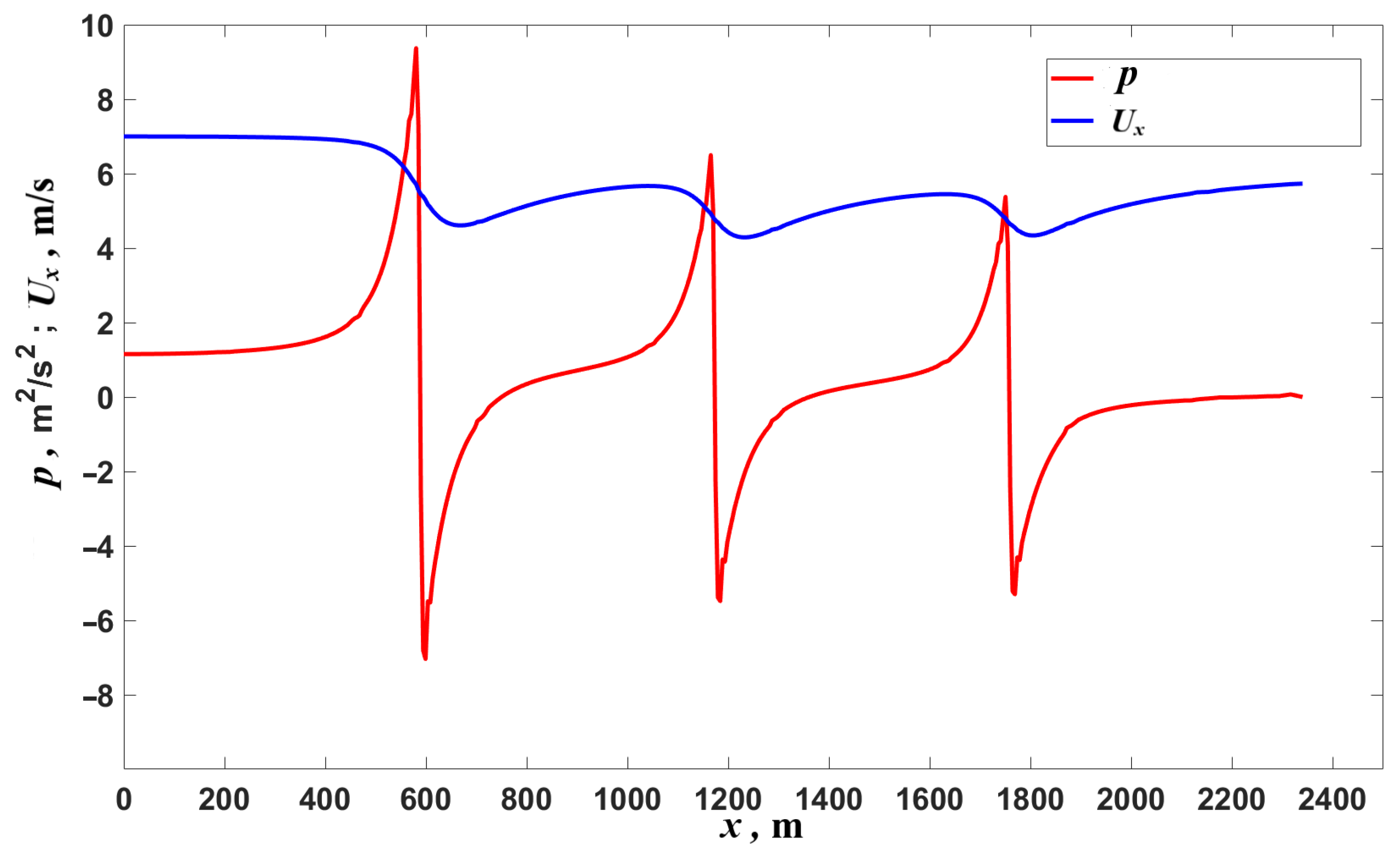

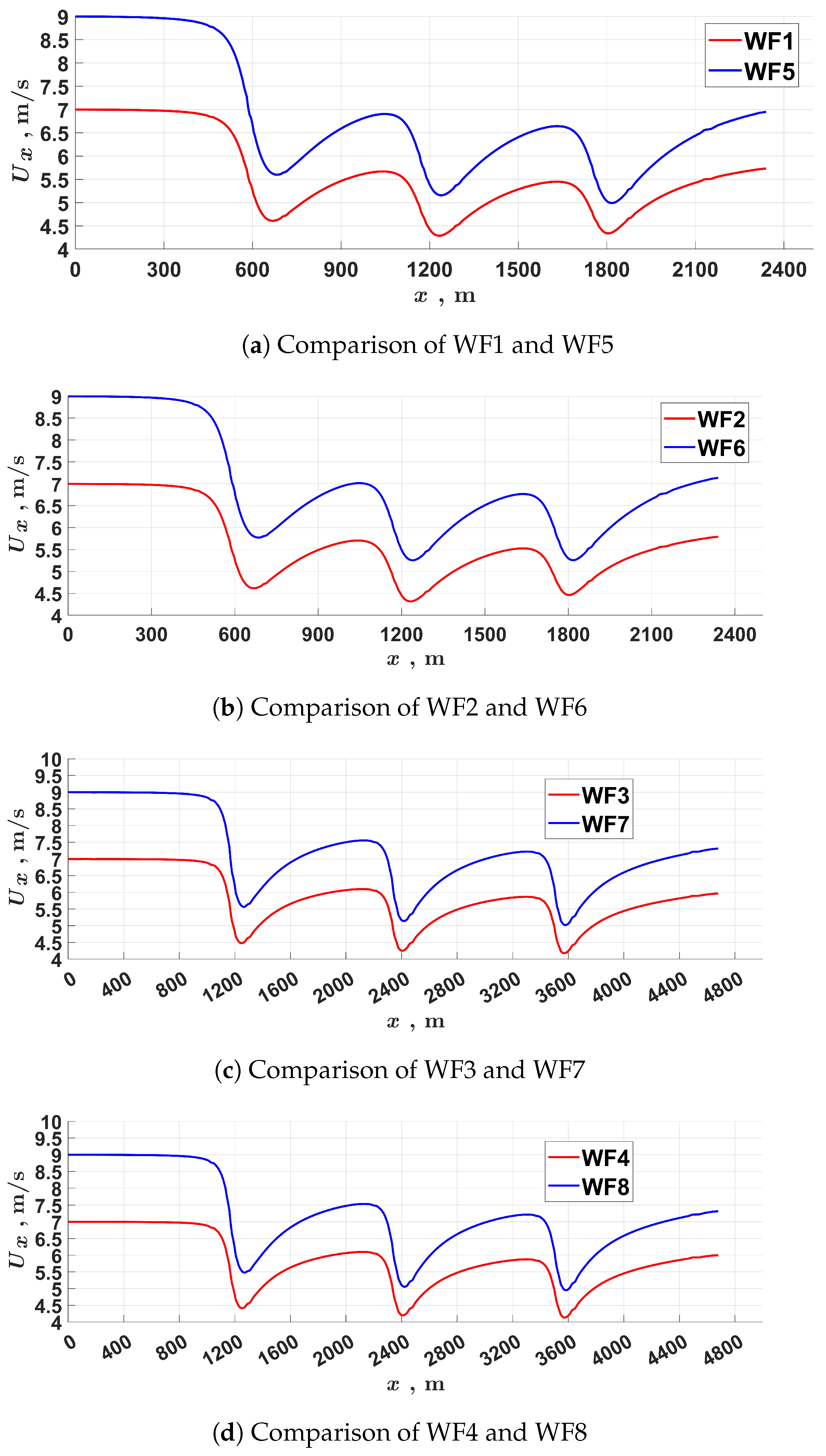
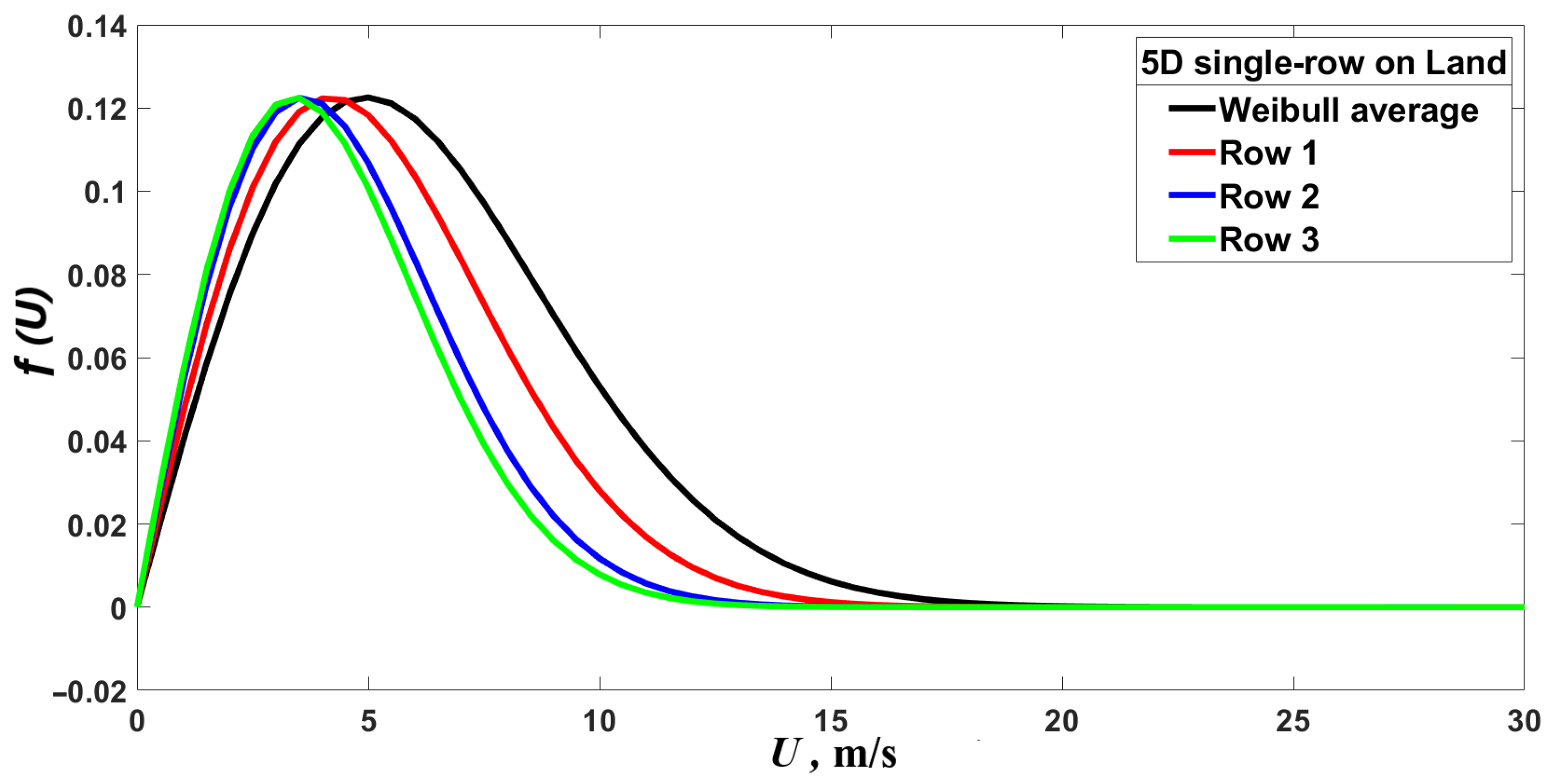
| Cut-in speed | 3 m/s |
| Cut-out speed | 27 m/s |
| Rotor diameter R | 132 m |
| Swept area | 13,685 m |
| Hub height | 120 m |
| WF | L | W | H | Inlet | Outlet | Left | Right | Top | Bottom | |
|---|---|---|---|---|---|---|---|---|---|---|
| 1 | 5D | 5D | 5D | 5D | ABL | OUT | slip | slip | slip | noslip |
| 2 | 5D | 5D | 2.5D | 5D | ABL | OUT | cyclic | cyclic | slip | noslip |
| 3 | 10D | 10D | 10D | 5D | ABL | OUT | slip | slip | slip | noslip |
| 4 | 10D | 10D | 5D | 10D | ABL | OUT | cyclic | cyclic | slip | noslip |
| 5 | 5D | 5D | 5D | 5D | ABL | OUT | slip | slip | slip | noslip |
| 6 | 5D | 5D | 2.5D | 5D | ABL | OUT | cyclic | cyclic | slip | noslip |
| 7 | 10D | 10D | 10D | 5D | ABL | OUT | slip | slip | slip | noslip |
| 8 | 10D | 10D | 5D | 10D | ABL | OUT | cyclic | cyclic | slip | noslip |
| WF | |||
|---|---|---|---|
| 1 | 0.8467 | 0.726 | 0.6868 |
| 2 | 0.8495 | 0.732 | 0.7005 |
| 3 | 0.8746 | 0.7833 | 0.7559 |
| 4 | 0.8772 | 0.7864 | 0.7598 |
| 5 | 0.869 | 0.6991 | 0.6827 |
| 6 | 0.8513 | 0.7049 | 0.6654 |
| 7 | 0.8747 | 0.7577 | 0.7256 |
| 8 | 0.8773 | 0.7596 | 0.7286 |
| WF | |||
|---|---|---|---|
| 1 | 1 | 0.897 | 0.840 |
| 2 | 1 | 0.900 | 0.849 |
| 3 | 1 | 0.926 | 0.886 |
| 4 | 1 | 0.927 | 0.888 |
| 5 | 1 | 0.880 | 0.831 |
| 6 | 1 | 0.893 | 0.838 |
| 7 | 1 | 0.918 | 0.876 |
| 8 | 1 | 0.918 | 0.876 |
| WF | AEG | |
|---|---|---|
| GWh | % | |
| 1 | 2630.5 | 16.0 |
| 2 | 2671.2 | 15.1 |
| 3 | 2907.9 | 11.4 |
| 4 | 2925.2 | 11.2 |
| 5 | 3033.3 | 16.9 |
| 6 | 2982.7 | 16.2 |
| 7 | 3221.5 | 12.4 |
| 8 | 3234.6 | 12.4 |
Disclaimer/Publisher’s Note: The statements, opinions and data contained in all publications are solely those of the individual author(s) and contributor(s) and not of MDPI and/or the editor(s). MDPI and/or the editor(s) disclaim responsibility for any injury to people or property resulting from any ideas, methods, instructions or products referred to in the content. |
© 2023 by the authors. Licensee MDPI, Basel, Switzerland. This article is an open access article distributed under the terms and conditions of the Creative Commons Attribution (CC BY) license (https://creativecommons.org/licenses/by/4.0/).
Share and Cite
Malecha, Z.; Dsouza, G. Modeling of Wind Turbine Interactions and Wind Farm Losses Using the Velocity-Dependent Actuator Disc Model. Computation 2023, 11, 213. https://doi.org/10.3390/computation11110213
Malecha Z, Dsouza G. Modeling of Wind Turbine Interactions and Wind Farm Losses Using the Velocity-Dependent Actuator Disc Model. Computation. 2023; 11(11):213. https://doi.org/10.3390/computation11110213
Chicago/Turabian StyleMalecha, Ziemowit, and Gideon Dsouza. 2023. "Modeling of Wind Turbine Interactions and Wind Farm Losses Using the Velocity-Dependent Actuator Disc Model" Computation 11, no. 11: 213. https://doi.org/10.3390/computation11110213
APA StyleMalecha, Z., & Dsouza, G. (2023). Modeling of Wind Turbine Interactions and Wind Farm Losses Using the Velocity-Dependent Actuator Disc Model. Computation, 11(11), 213. https://doi.org/10.3390/computation11110213







